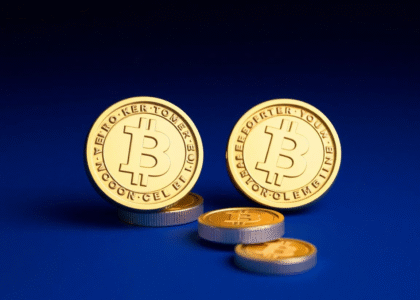Cryptocurrency, the digital asset that’s been stirring up global financial markets, has caught the world’s investors and traders in its magnetic pull. As interest in these digital currencies escalates, newcomers seek ways to take a slice of the tantalizing crypto pie. This comprehensive guide is your ticket to the thrilling world of cryptocurrency trading.
Part One: Getting to Grips with Cryptocurrency
1.1 Cryptocurrency Uncovered
A digital or virtual currency safeguarded by cryptography and thriving on a decentralized system called the blockchain – that’s cryptocurrency in a nutshell. Bitcoin, the crypto poster child, first came into the scene in 2009, unveiled by the enigmatic Satoshi Nakamoto [1].
[1] https://www.investopedia.com/terms/c/cryptocurrency.asp
1.2 The Crypto Mechanics
Operating on decentralized networks composed of nodes (computers) that validate and record transactions, cryptocurrencies create a public ledger — the blockchain. This system safeguards transactional integrity, provides transparency, and ensures secure data storage.
1.3 Blockchain: The Backbone of Cryptocurrencies
Blockchain technology is the driving force behind cryptocurrencies, offering secure, transparent, and decentralized digital transactions. This technology has the potential to revolutionize industries like finance, supply chain, and healthcare.
Part Two: Setting Sail on Your Cryptocurrency Trading Voyage
2.1 Choosing the Right Cryptocurrency Exchange
Your first step in crypto trading is picking a reliable exchange like Coinbase, Binance, or Kraken. These platforms simplify the buying, selling, and trading of a broad array of cryptocurrencies.
2.2 Securing Your Account
After choosing an exchange, it’s time to set up an account. Provide your email address, password, and identification. Remember, cybersecurity is paramount; enable two-factor authentication (2FA) and opt for a strong, unique password.
2.3 Getting Your Account Ready for Action
Next, fund your account to kickstart your trading journey. Most exchanges accept bank transfers, credit cards, and occasionally PayPal. Be sure to familiarize yourself with the fees for deposits and withdrawals, as they vary among exchanges.
2.4 Delving into the World of Cryptocurrencies
Before diving into trading, acquaint yourself with the vast range of cryptocurrencies available. Beyond the market dominators, Bitcoin and Ethereum, thousands of altcoins boast unique features and uses. Investigate their technology, potential, and fundamentals to make educated investment decisions.
Part Three: Perfecting Your Cryptocurrency Trading Tactics
3.1 Crafting Your Trading Strategy
To elevate your chances of success, create a trading strategy aligned with your goals, risk tolerance, and availability. Evaluate the pros and cons of popular strategies such as day trading, swing trading, and long-term investing.
3.2 Unpacking Technical Analysis
Technical analysis involves studying historical price charts and various indicators to predict future price movements. Tools of the trade include moving averages, trend lines, and oscillators such as the Relative Strength Index (RSI) and Moving Average Convergence Divergence (MACD).
3.3 Navigating Fundamental Analysis
Fundamental analysis is the process of determining a cryptocurrency’s inherent value by scrutinizing its underlying technology, team, and market potential. This method often includes reviewing whitepapers, studying industry trends, and keeping up-to-date with cryptocurrency news.
3.4 Managing Risk
Effective risk management is key to successful cryptocurrency trading. Minimize losses with stop-loss orders, diversify your portfolio, and follow the golden rule: never invest more than you can afford to lose. Emotional discipline and avoiding impulsive decisions are also vital.
Part Four: Keeping Your Finger on the Pulse
4.1 Staying Up-to-Date with Cryptocurrency News
Stay ahead of the game by keeping up with the latest news from reliable crypto sources like CoinDesk, Cointelegraph, and The Block. Additionally, consider subscribing to newsletters, following influential figures in the industry on social media, and participating in online forums and communities.
4.2 Investing in Your Trading Skills and Knowledge
Successful cryptocurrency traders are lifelong learners, always adapting to the rapidly shifting landscape. Online courses, webinars, and books are excellent resources for expanding your understanding of trading strategies, risk management, and market analysis [2].
[2] https://www.forbes.com/advisor/investing/how-to-buy-bitcoin/
4.3 Networking and Collaborating with Fellow Traders
Building a network with other traders can provide invaluable insights and foster a sense of community. Participate in local meetups, online discussions, and social media groups where traders share ideas and keep up with market trends.
The Takeaway
The exciting world of cryptocurrency trading beckons, presenting a promising venture for beginners ready to explore the realm of digital currency. By mastering the fundamentals of cryptocurrency, picking a trusted exchange, crafting a solid trading strategy, and staying well-informed, you’re setting yourself up for success in this rapidly evolving marketplace. Let the trading begin!
FAQs
What is cryptocurrency trading?
It’s like trading stocks, but with digital assets like Bitcoin and Ethereum. Instead of shares, you buy/sell crypto coins or tokens.
How do I start trading?
Easy peasy! First, pick a reputable crypto exchange like Binance or Coinbase. Sign up, deposit some fiat (traditional currency), and start swapping for crypto.
What’s the difference between hodling and trading?
Hodling means you buy and hold onto a crypto for the long run. Trading is actively buying and selling to capitalize on short-term price moves. Hodlers are in it for the long game; traders are after those quick gains!
Can I lose all my money?
Totally, mate. Crypto trading is volatile. Never invest more than you can afford to lose. DYOR (Do Your Own Research) and maybe even consider a stop-loss strategy to limit potential losses.
What are altcoins?
Altcoins are basically any crypto that’s not Bitcoin. Think Ethereum, Ripple, or Dogecoin. They can offer greater returns but often come with increased risk.
What’s TA?
That’s Technical Analysis. It’s all about studying price charts and using historical data to predict future price movements. Fancy stuff like candlestick patterns and moving averages, you know?
And what about FA?
FA stands for Fundamental Analysis. It focuses on the big picture, like a coin’s tech, team, and real-world use cases. Think of it as getting to know the soul of a crypto.
Should I day trade or swing trade?
Day trading means you’re in and out within a day. Swing trading is a bit longer, maybe days or weeks. Day trading’s intense; swing trading’s more chill. Your call!
How do I secure my investments?
Always use 2FA (Two-Factor Authentication) on exchanges. And consider using a hardware wallet. It’s like a crypto safe for your precious coins!
What’s a bullish or bearish market?
Bullish = prices going up (think charging bull). Bearish = prices going down (like a hibernating bear). So, are you feeling bullish today?
Can I practice before using real money?
Totally! Many exchanges offer paper trading or demo accounts. It’s like playing a video game, but with virtual money. Dive in and get those newbie jitters out!
How important is community in crypto trading?
Huge! Join crypto communities like Reddit’s r/cryptocurrency or Twitter crypto fams. Get insights, share memes, and always remember: we’re all in this wild ride together!






